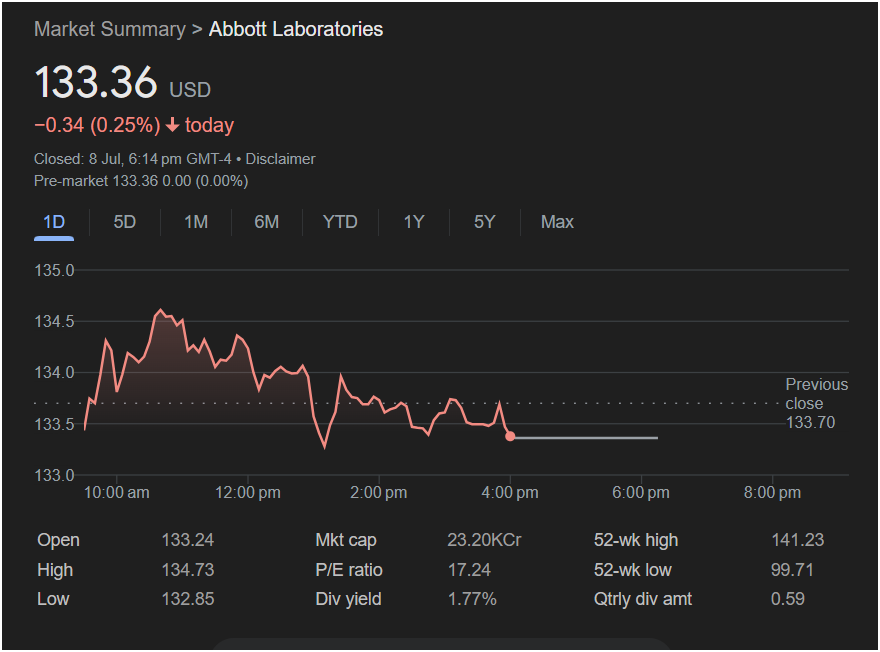Abbott Laboratories Slips 0.25% in Muted Session, but Defensive Strength Shines Through Intraday Volatility

ABBOTT PARK, Ill., July 8 – Shares of the global healthcare and medical technology leader Abbott Laboratories (NYSE: ABT) ended a choppy trading session with a nominal loss, showcasing the characteristics of a blue-chip stalwart navigating a listless market. The stock closed at
0.34 or 0.25%, in a day that saw an early rally attempt ultimately fade.
The session was a quiet tug-of-war between buyers looking for value in a defensive leader and sellers taking profits after a morning surge. The stock charted a volatile path, opening at $133.24 and rallying strongly to an intraday high of $134.73, only to reverse course and touch a low of $132.85 before finding equilibrium. This price action, while resulting in a slight decline, underscores the stock’s role as a stable anchor in investor portfolios, resilient even when it fails to gain ground.
Reflecting the session’s indecisive conclusion, pre-market data for the following day was perfectly flat, with the stock indicated at $133.36, unchanged from its close. This suggests a market waiting for a new catalyst to dictate direction for this healthcare giant.
Section 1: Anatomy of an Indecisive Day – A Microscopic View of the Trading Session
The day’s small 0.25% loss belies a more dramatic intraday narrative of a failed rally, revealing the subtle push and pull of market forces acting on a defensive, large-cap stock.
The Early Morning Rally Attempt (9:30 AM – 11:00 AM EST)
The trading day began on a slightly soft note, with the stock opening at $133.24, below the previous close of $133.70. However, this initial weakness was immediately met with a strong wave of buying interest. In the first hour of trading, Abbott shares embarked on a confident rally, climbing steadily through the $134 level.
This surge culminated around 10:30 AM EST, when the stock reached its intraday high of $134.73. At this peak, the stock was up nearly 1.2% from its opening price and a solid 0.77% on the day. This strong opening move can be attributed to several factors. It could represent institutional buyers executing orders, seeing the stock as attractively priced, or a broader market sentiment favoring defensive, “safe-haven” sectors like healthcare at the start of the day. For a brief period, it appeared Abbott was poised for a strong breakout session.
The Midday Fade and Reversal (11:00 AM – 2:00 PM EST)
The bullish momentum, however, proved to be unsustainable. From its morning peak, the stock began a slow but steady decline. The chart shows a “sawtooth” pattern downward as sellers began to emerge, taking profits from the early rally. The buying pressure that had been so evident at the open dissipated, and the stock gradually gave back all of its gains.
The reversal accelerated shortly after 1:00 PM EST, as the stock broke below its opening price and the previous day’s close. This move pushed Abbott to its intraday low of $132.85. This midday fade is a classic sign of a lack of conviction. The initial rally failed to attract follow-through buying, and as the price began to stall, those who bought early decided to sell, creating a self-reinforcing downward drift. This pattern suggests that while there is underlying support for the stock, there isn’t an aggressive appetite to chase it higher at these levels.
Afternoon Stabilization and a Quiet Close (2:00 PM – 4:00 PM EST)
After hitting its low, the selling pressure abated. The stock found a floor of support and spent the remainder of the afternoon session in a tight, sideways consolidation pattern. It managed to claw its way back above the $133 mark but showed no renewed upward momentum.
The session closed with the stock drifting quietly, ending at $133.36. This flat close, after the day’s volatility, signifies an equilibrium. The morning bulls and the midday bears fought to a standstill, with the market ultimately deciding that a price around $133.50 was fair value for the day. The flat pre-market activity for the next session further reinforces this sense of temporary balance.
Section 2: The Bedrock of Value – A Deep Dive into Abbott’s Financials
The day’s quiet trading is best understood through the lens of Abbott’s solid and appealing financial metrics, which position it as a core holding for a vast swath of investors.
Market Capitalization (Mkt cap): 23.20KCr
The market capitalization, listed with the Indian notation “KCr” (Thousand Crore), translates to an immense valuation of approximately $232 Billion USD. This places Abbott Laboratories in the upper echelon of global healthcare companies. This massive scale provides significant advantages, including a diversified revenue stream, substantial resources for research and development, and a powerful global distribution network. This size and market leadership are key sources of its stability and defensive appeal.
The Case for Value (P/E Ratio: 17.24)
In today’s market, Abbott’s Price-to-Earnings (P/E) ratio of 17.24 is a standout figure that screams “value” and “quality.” This metric indicates that the stock is trading at just over 17 times its trailing annual earnings. This is a very reasonable, if not outright attractive, valuation for a market-leading company with consistent profitability.
It stands in stark contrast to the high-flying P/E ratios of the technology and AI sectors. A P/E of 17.24 suggests that the stock’s price is firmly grounded in its current, proven earnings power, not on speculative hopes for the distant future. For conservative and value-oriented investors, this low P/E reduces perceived risk and provides a margin of safety, making it a compelling alternative to more richly valued areas of the market.
The Shareholder’s Reward (Dividend Yield: 1.77% & Quarterly Dividend: $0.59)
Abbott’s commitment to returning capital to shareholders is a cornerstone of its investment thesis. With a dividend yield of 1.77%, the stock provides a steady and reliable income stream. This is powered by a quarterly dividend of $0.59 per share, which annualizes to $2.36 per share.
Crucially, Abbott is a member of the elite S&P 500 Dividend Aristocrats, a group of companies that have increased their dividend for at least 25 consecutive years. In fact, Abbott has raised its dividend for over 50 consecutive years, making it a “Dividend King.” This remarkable track record provides immense confidence to income-focused investors, such as retirees, who depend on predictable cash flow from their portfolios.
Context is Key (52-Week Range: $99.71 – $141.23)
The closing price of $133.36 is positioned firmly in the upper half of its 52-week range. This demonstrates that the stock has been in a healthy uptrend, having recovered significantly from its low of $99.71. It is trading with strength but remains below its 52-week high of $141.23, suggesting there is still potential room for appreciation before encountering major technical resistance. The day’s trading pattern, a consolidation near the upper end of its yearly range, is a constructive sign for the long-term trend.
Section 3: The Broader Narrative – The Indispensable Role of a Healthcare Titan
Abbott’s stock performance is deeply intertwined with its fundamental role in the global healthcare ecosystem.
The Ultimate Defensive Stock: Abbott’s business is fundamentally non-cyclical. Demand for its products—medical devices, diagnostic tests, nutritional products, and established pharmaceuticals—is driven by demographic trends like aging populations and the prevalence of chronic diseases, not by the state of the economy. People need pacemakers, glucose monitors, and infant formula regardless of whether the economy is in a boom or a recession. This makes ABT a classic “defensive” or “safe-haven” stock that investors flock to during times of market uncertainty.
A Diversified Powerhouse: Abbott’s strength lies in its diversification across four major business segments:
-
Medical Devices: This is a key growth engine, featuring market-leading products in cardiovascular care (stents, heart valves), rhythm management (pacemakers), and diabetes care. The FreeStyle Libre continuous glucose monitoring (CGM) system is a blockbuster product that is transforming diabetes management and driving significant growth.
-
Diagnostics: This segment provides a wide array of tests and instruments for hospitals and laboratories. It experienced a massive, temporary boom from COVID-19 testing, and is now normalizing as the world moves past the pandemic, demonstrating the strength of its core testing business.
-
Nutrition: Home to iconic brands like Ensure (adult nutrition) and Similac (infant formula), this segment provides stable, recurring revenue.
-
Established Pharmaceuticals: This division sells a portfolio of trusted, branded generic drugs in emerging markets, providing steady cash flow.
This diversification means that weakness in one area can be offset by strength in another, leading to highly predictable and stable overall performance.
Innovation as the Lifeblood: The future of any healthcare company depends on innovation. Abbott consistently invests billions in R&D to develop the next generation of life-changing technologies. Future growth will be driven by new product launches, expanded indications for existing devices (like the FreeStyle Libre), and acquisitions that bring new technologies into its portfolio.
A Portrait of Stability in an Unstable World
Tuesday’s trading session for Abbott Laboratories was the epitome of its character: a brief flash of excitement followed by a return to quiet, steady resilience. The 0.25% decline is statistically insignificant, but the journey to get there—a failed rally followed by a firm defense of its lows—is highly informative. It paints a picture of a stock that is fairly valued, well-supported, and fulfilling its role as a portfolio anchor.
In a market often captivated by speculative fervor and dizzying volatility, Abbott stands as a testament to the enduring appeal of quality, value, and predictability. Its attractive valuation, a “Dividend King” status, and its indispensable role in global healthcare create a powerful investment case. The day’s trading showed that while it may not always lead the market on its best days, it provides a crucial bedrock of stability when conviction is in short supply.






